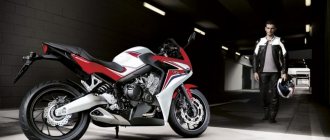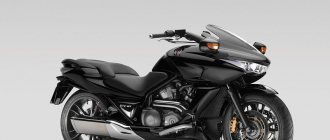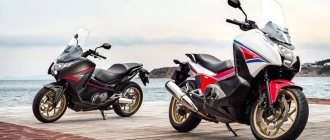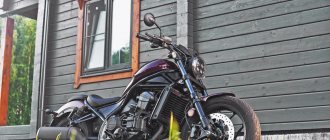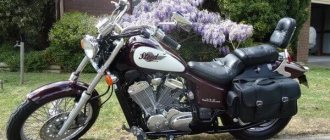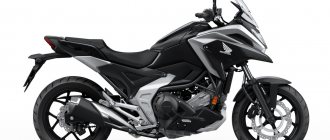Between two horses
The most convenient way to pick up a motorcycle for testing is on your own bike. There is no need to strain your friends and colleagues by persuading them to give you a lift to distant lands. You don’t have to live for a week without your car, left who knows where. There is no need to travel on public transport with a helmet and a full set of equipment in your armful. You just need to change from one motorcycle to another - you are back on horseback.
The ride behind the Honda CB1100 was a separate short trip. From my house to the main office of Honda Motor there are almost fifty kilometers, a fair part of them are beyond the Moscow Ring Road.
Driving out of town in the morning “against the grain” is a pleasure: having promptly exchanged Michurinsky Prospekt for Borovskoe Highway, I rushed into the region towards Solntsevo. Finally, flying past Vnukovo airport, I burst into the village of Sharapovo, where a SV1100 shiny with fresh chrome was already waiting for me.
Having put my bike in the stall next to his younger relatives, I turned my attention to the “liter-hundred”, with whom I had to communicate for a whole week. Despite the fact that my old Honda and new Seabisha are separated by almost two decades, the connection between generations is obvious - with some allowance for technological progress.
The ergonomics of the seating position are determined by the fact that the motorcycles belong to the same type: both are classics in their purest form, without any impurities. The saddle, the controls, the dashboard - all this is molded according to a time-tested recipe, there is no feeling of deja vu, but it still hits you with nostalgia. The headlight is round, again. The steering wheel switches have not changed functionally, except that a hazard warning button has been added. The canonical instruments, recessed in shiny wells, are diversified by a small display on which I found what I so lacked on my own motorcycle: a clock and a fuel level indicator. And the fuel filler cap has not changed one iota - an exact copy of the one that adorns the tank of my Honda.
The gas tank itself is a piece of modern art; it would be quite appropriate on a much more modern model of motorcycle equipment. At the same time, the tank is emphatically functional - it is very convenient to hold onto it with your knees when turning. And this is important, because the SV1100 is well trained in the intricacies of fast driving. And not just in a straight line.
You won’t be able to hide behind the fairing at high speed: the CB1100 simply doesn’t have it
Photo: Dmitry Lebedev, Kommersant
Main modifications of the Honda CB 1100
Honda CB 1100 - regular version.
Honda CB 1100 DLX (Deluxe) - available since 2014. Based on the 2nd generation CB1100. It features a larger fuel tank (16.8 liters), 4-into-2 exhaust, ABS, a different seat and some other details.
Honda CB 1100 EX - available since 2014. Based on the Deluxe (DLX) modification, but differs in spoked wheels.
Honda CB 1100 RS - available from 2021. It features new rims, 120 and 180 mm tires, LED optics, a wheelbase shortened by 5 mm, new suspensions (43 mm fork, Showa rear shock absorbers with remote reservoirs; gold color), new Tokico brakes with radial calipers and larger discs diameter (310 mm).
Our everything
Everything is relative. Let's say, 90 horsepower - is it a lot or a little? For a 600 cc sportbike this is not enough, but for a 1.5 liter chopper, oddly enough, it is quite enough. It all depends on what the motorcycle needs to be able to do. And how does our classic manage this goodness, hidden in an in-line “four” with a volume of 1140 cubic meters?
The Honda CB1100 allows you to start very delicately - this is the merit of a light clutch lever with a hydraulic drive and solid torque, which is not piled up at the top, like in sportbikes with four-cylinder engines, but is spread thickly across the entire rev range. The insinuation with which the “seabiga” comes into motion is captivating: the device gently and quietly rolls forward, as if on an electric motor. What if you open up more?
As English-speaking comrades say, nothing beats cubic inches. In other words, working volume is everything to us! One hundred liters are one hundred liters, on the SV1100 you feel it all the time. As far as you dare, you will go. I didn’t immediately become bolder and at first I whispered on the in-line “four”, like on a low-powered V-twin, walking the tachometer needle in the moderate speed zone. It turned out well: acceleration was vigorous and confident. True, with such a ride, I quickly ran out of steps in the box - there are only five of them, and not six, like the vast majority of modern motorcycles. Several times I found myself trying to shift up while already in top gear.
Or maybe I shouldn’t be doing this? Maybe you shouldn’t force the SV1100 with speed? In the end, the classic has zero hooding, and you meet the air masses with your own body. This becomes a problem after the speedometer needle passes the 120 km/h mark: the air flow puts more and more pressure on your head and shoulders and at some point already hints at the possibility of separating you from the motorcycle. No, you can, of course, clutch the steering wheel and try to force the speedometer to count all new records, since the SV1100 doesn’t cost anything except fuel consumption. However, such feats already go against pleasure. Well, in fact, if you really need maximum speed, get on a sportbike and hide from the wind behind a plastic wall, bending over.
But this is not our way. Since a motorcycle gives you the opportunity to ride beautifully, you should not miss it under any circumstances. Where in Moscow can a motorcyclist sell beauty at a higher price?
Narrow wheels have the most favorable effect on the maneuverability of the bike.
Photo: Dmitry Lebedev, Kommersant
New in the classics
One evening I went down to the garage, started the SV1100 and went “to the mountain” - to the observation deck in front of the Moscow State University building. “On the mountain,” I dismounted and called a friend who, according to my calculations, was supposed to be waiting for me at the appointed place. And sure enough, Vova was right there. He critically examined the "Siberian Sea" and seemed to be slightly disappointed.
- Heh, I thought your vaunted Honda would be more modern. And it looks even older than my former SV400, which I learned to drive.
- Vova, this is not old, this is vintage! And then, your “scabies” is listed as a neoclassicist, but this is just a classic. The most classic classic ever.
- Well, so be it. What kind of motor? Liter?
- Take it higher - a hundred liters! Ninety powers.
- But this is less than in my sports “six hundred” (Honda CBR600RR sportbike. - V.O.
)!
— Yes, but the CB1100 has a third more torque.
It was noticeable that Vova was skeptical about the talents of the big “sibikha”. However, all skepticism disappeared when he took the SV1100 for a ride.
- Listen, great technique! It can’t be compared to “scabies” at all. It steers just magically. The brakes are super, and there is an anti-lock braking system.
— Have you noticed that when braking with the rear wheel, the front wheel also grabs slightly? This is a combined ABS, you can brake effectively even when the bike is at a strong incline. Thing!
Air-oil cooling: fins on the cylinders and a small oil cooler are responsible for this
Photo: Dmitry Lebedev, Kommersant
- Yes, I noticed. And the frame is also very rigid. My old "Sibiha" was all out and about at the turn, but here - nothing like that. And the engine is just what you need: if you don’t drop below four thousand rpm, you accelerate simply beautifully. Really cool mot!
Cool, I agree. Very cool - and very classic. Almost ideal. Although why “almost”? No sixth gear? But the SV1100 doesn’t really need it: the wide operating range of the engine allows you to drive with a minimum of switching. Not old school alloy wheels enough? But the tires are tubeless. Quiet exhaust? And this can be easily fixed - we install a custom muffler. Or even two, spreading the issue on both sides - for greater beauty.
And then the dreamer mode inside me turned on. I realized that I needed just such a bike to be happy. He has everything I need: a spectacular, timeless appearance; and a living wage (in the literal sense) in the form of an advanced braking system with proprietary C-ABS; and legendary Japanese reliability, thanks to which I am unlikely to ever turn from a rider to a mechanic.
And at the same time - the price. The Honda CB1100 costs less than half a million rubles, and is the most affordable motorcycle I have tested. And he is the fastest, most stylish and most memorable.
Honda CB1100 RS 2021 – Flask of Time
Is it possible to stop time? This question cannot be answered unambiguously. On the one hand, we have the inviolable laws of physics that clearly prohibit stopping the passage of time. On the other hand, in addition to all the quantum exoticism that does not prohibit time travel, we have museums that store samples and artifacts of a particular era, and human imagination can immerse us in almost any era. Many people devote themselves to studying and reconstructing past times in order to immerse other people in them. So the question about time travel is more like this: how difficult is it to experience yourself in another time? The answer is individual and depends on imagination, but imagination can already be helped by creating the appropriate environment and atmosphere.
Today I offer you, my dear reader, a small immersion into the atmosphere of days gone by.
And let me tell you a little about where we will dive, create the appropriate atmosphere, so to speak. So, the 70s of the 20th century. A generation of people has matured who only heard about the hysterical wail of an air raid siren and the crackle of machine gun fire from the stories of the older generation. Yes, there are enough tense points in the world, there is a “cold war”, and, as its hottest manifestation, the war in Vietnam. But the generation of the 70s was tired of wars and conflicts, tired of having to survive and not live. This resulted in the 70s becoming a time of “freedom”. The younger generation decided to go beyond the boundaries, self-expression became a kind of icon. Many have delved deeper into understanding themselves and their place in this world. Each social, cultural or subcultural group created its own style and way of life, and, like icing on the cake, the firm tread of the sexual revolution, heavily implicated in the availability of psychotropic substances. And this was in almost everything: in music, in painting, in architecture, in design. Yes, even, damn it, in cooking!
Well, what about motorcycles? Well, motorcycles of the 70s era were also quite diverse. Cruisers, or motorcycles for tourism, have already begun to acquire panniers and fairings, and choppers have fixed their canonical appearance. However, for the most part, these were the same “classic” devices, outwardly not very far removed from a bicycle without pedals, but with an engine. Sports motorcycles are also a little behind them. Yes, the obvious advantages of aerodynamics perched cockpit-like fairings on the front and forced the pilot to take a rather strange pose, but still, they are far from modern, precise aerodynamic forms. Compared to aviation, these were no longer bulky multiplanes made of wood and fabric with braces on the wings, but the F-117 Night Hawk was still far away.
Civilian versions of sports motorcycles (although here it is impossible to say for sure what was primary and what was built from what - sports motorcycles from civilian ones or, on the contrary, civilian ones created on the basis of racing versions, it will not work, but this does not change the essence) were changed mainly by removing the fairings , and the return of such parts that are not needed in motorsports, such as headlights and turn signals. However, this was a very successful marketing ploy - the client saw an athlete at the races, dashing along the track on a motorcycle almost the same as the one on which he himself arrived. It gave a feeling of belonging. Such motorcycles, which looked like their sports counterparts, began to be called superbikes (SuperBike). And this, in itself, gave birth to a new fashion and a new subculture. The seeds of a superbike fell into the very fertile soil of Cafe Racers, they were a kind of stimulus for development and reborn cafe racers into street fighters. In essence, nothing has changed: the same strong guys in leather jackets, representatives of the “working youth,” so to speak. They, just like in the 50s and 60s, rushed along the roads to show off their brave prowess, entered into conflicts with government officials, and had “tender” relationships with other subcultures. In general, a kind of stereotypically romanticized image of a “bad guy” on a noisy, dirty, but damn fast motorcycle.
And now that, I hope, I have created the necessary atmosphere of creative madness with lysergic ponies to the sounds of disco and the roar of heavy engines, I will still move on to our today’s hero: the Honda CB1100RS - a classic superbike of the 70s, a little more than completely.
Well, here it must be said that all the signs of “that same superbike” are observed exactly. Duplex frame made of steel pipes, spoked wheels (cast wheels were certainly already in use, but were still a luxury that not everyone could afford), air-oil-cooled engine, chrome-plated exhaust pipes on both sides of the motorcycle, rounded two-seater saddle, straight landing, round headlight and a simple brake light located on the wing. A minimum of decorative and other unnecessary details, and a maximum of load-bearing elements on display. It would seem that everything is simple and banal, and, in general, even ordinary, but the devil, as we know, is in the details.
Let's start with the fit and ergonomics. The seat looks quite simple, an ordinary two-seater “sofa”, with only a nominal hint of a “step”, which should mean poor support for the fifth point. But when you sit on this seat, it is pressed down somewhat, and the emphasis becomes very noticeable, which significantly adds to comfort. The legs habitually find the footrests, the hands find the handles themselves, the fingers precisely fall on the levers, all movements and positions are on an intuitive level, classic. In general, the ergonomics suggest some forward lean, making the riding position moderately aggressive, but not so much that it is noticeable. The remote controls on the steering wheel, by the way, are ascetic, one might even say rustic, the range of functions is minimal, but everything is at hand and there is nothing superfluous. You definitely won't get lost in the buttons.
The chassis is also not overly complex: a steel backbone made of pipes, a tank on it, a motor under the tank, two spoked wheels, two front stays, two shock absorbers at the rear, disc brakes - that’s, in fact, the whole simple set. But all together it gives amazing maneuverability. Rigid frame, front suspension, although not a newfangled “changeover”, but quite modern, rear shock absorbers of a backpack type, everything is from Showa and most likely corresponds to the 21st century. A minimal, but still sufficient, set of suspension adjustments, tenacious brakes with ABS and excellent feedback, all this together makes the motorcycle quite nimble, even aggressive. It takes turns with great pleasure; it moves along the trajectory like a locomotive on rails, no wobbling, yawing, drifting or wobbling. Only the considerable mass of all these cast iron, and not aluminum, parts makes control, let’s say, physically necessary. That is, in order to do something, you need to do it with your hands and body, demonstrate your will clearly, make an effort. But if you are a real man, and not a “slim young man with glasses,” you are unlikely to even notice the efforts being made, and the need to express your desires so specifically will be more likely to be a pleasure. Maneuvering in city traffic is also not satisfactory. The low center of gravity and almost upright seating position make the ride not just comfortable, but I would even say provocative.
Now a little about the exterior. The appearance is simple, but at the same time exemplarily stylish, within the framework of its era, of course. An equal mix of chrome, polished and black, rough-looking details creates the necessary aesthetics. All elements combine perfectly with each other, emphasizing a strict retro sporty style, nothing superfluous, everything to the point. But even here there are some inclusions of modernity. I'll start with the headlight. The round classic headlight is located and fixed on the traverses, everything, it would seem, is within the canon. But the optics inside are LED, with an abundance of lenses, which is somewhat confusing and clearly does not fit into classical concepts, although it does not spoil the overall impression. And given that even outside the city, on a deep moonless night, this optics does its job, perfectly illuminating the trajectory, then this is, perhaps, a feature, not a bug. The dashboard deserves a separate story. She really stuck with me. Two dial wells for speedometer and tachometer. Between them is a small LCD display, with white numbers on a dark blue background, the central place of which is occupied by the gear indicator. Indicator icons light up only when needed, the rest of the time they blend into the background. All this is crowned with an almost sexy soft white backlight. It just makes me shiver how tasty, juicy and beautiful it is. The information content of this dashboard is exactly at the required level, a sufficient minimum, period. I think there is no point in saying too much that the readability of instruments in any road conditions and in any lighting conditions is more than excellent. The only thing left to mention is the rear light, also known as the brake light, which doesn’t stand out with anything special here except for its LED filling. But visually it fits so organically into the image of the motorcycle that it is taken for granted and would most likely raise questions if it were anything else.
Well, now let's move on to the fiery heart. And here I was disappointed. 90 horsepower and 91 Nm of torque are infinitesimal for an engine with a volume of 1100 cubic centimeters. This is so small that it does not even cause irritation or anger, but sadness and melancholy. All the manufacturer's claims that they were inspired by the superbikes of the 70s are crushed by these characteristics. Yes, it looks and feels like a 70's bike, and for a 70's motorcycle this engine output is also quite good. But, damn it, we live in the 21st century, and from a motorcycle positioned as a racing motorcycle, even adjusted for the retro prefix, you expect something completely different. Yes, you don’t expect dynamic characteristics from it at the level of a modern sportbike, but you do expect some spice, aggression, a kind of strong, lively old man. Yes, the youth, of course, cannot be caught up, but the bones are strong, the eyes and heart are fiery, and the spirit is ardent, and that means the youth will not go far. What do we have instead? Instead, we have a museum piece, a flask of time, so to speak. A 70s superbike in every sense of the word. Yes, in the 70s they knew how to make fast motorcycles, but they were fast in the 70s, but today they are...
Against this background, all previous inclusions of modernity look truly inappropriate. If you create a museum, one might say, bench copy of a motorcycle from the 70s, then you could limit yourself to ABS (which is now a mandatory safety element and the production of vehicles without it is simply prohibited by law in many countries) and fuel injection, visually stylizing it as carburetors. Why this electronics, why lensed optics? We are creating a museum exhibit! On the other hand, if a modern motorcycle was created, stylized, both aesthetically and spiritually, according to the samples of the 70s, then where the hell is the spirit of the 70s? This motorcycle simply destroyed the spirit of that time, its aesthetics and eclecticism. Instead of a lively, strong old man, we got a flabby athlete who, for some unknown reason, had his face lifted and rejuvenated. It looks ridiculous.
The most offensive thing about this is that this motorcycle could be completely different. By adding everything-nothing 20-25 hp, and with the current degree of “boost” of the 1100 cc engine, this is not only possible, but will not even be difficult (BMW takes 200 hp from an engine with a volume of 100 cc less), and the motorcycle will be transformed beyond recognition . The ugly duckling will overnight turn into, not just a swan, a hawk, perhaps an elderly one, but still a hawk. Moreover, the rigidity of the frame and suspension, as well as the tenacity of the brakes, clearly indicate that the motorcycle was supposed to be completely different, or that the Japanese do not know how to design motorcycles. Somehow I don’t really believe the latter.
Riding this motorcycle is a lot of fun until you start to run into a lack of power. There is more than enough power for walking around the city in the evening from cafe to cafe. But anything more is not very good. Yes, the 1100 cc engine is very elastic, the main epithet that characterizes it is viscous. Like all in-line classics, it pulls, pulls, and pulls again, but due to the lack of this same traction, it has to be turned, and as a result, click the gears, but this still does not save... The notorious viscosity of large low-speed in-line engines, and the 1100 cc engine with a red zone starting at 8500 rpm - this is precisely a large low-speed rower that should envelop, envelop. The dynamics of this motorcycle should be similar to the dynamics of a locomotive - unhurried, but also inevitable. And I have something to compare with. At one time I rode a Honda CB1000 Big One from 1995. But there was 100 cubic meters less volume, and at the same time almost 100 hp and the same 90 Nm of torque. It felt completely different, it felt exactly like a diesel locomotive on takeoff.
And on this slightly minor note, I want to end my story. Finally, I would like to say that I liked the motorcycle. Yes, yes, I really liked it. Despite everything, it really is that sealed flask of time that will allow its owner to feel like in the era of the 70s, where disco and bright colors rule, where no creativity is persecuted (although, perhaps, it is condemned by someone). True, this flask still needs to be opened. If you like classic motorcycles, but don't want a museum display piece to put under glass and blow off the dust, but want to ride it every day, then this is definitely your choice. Yes, this motorcycle has a big drawback, but if your hands grow from the right place, and I am sure of you, then this will not become any obstacle for you. Well, if you are too busy to do it yourself, write to me, I will fix everything, not for free, of course, but I think we can agree)
So I take my leave. Thanks for reading. Always to yours Shtradman.
Special thanks to Honda Motor RUS for the motorcycle provided.

